Looking for a go to market strategy template to get your organisation ready for its next (or first!) big launch? Look no further – we’ve put together a robust and easily adaptable six-step guide to help you create a go to market strategy template you can use straight away as you prepare your new business venture for success.
What Is a Go To Market Strategy?
Before we dive into the details of your go to market strategy template, let’s first define what a GTM strategy is.
Gartner offers the following definition: “A go to market (GTM) strategy is a plan that details how an organisation can engage with customers to convince them to buy their product or service and to gain a competitive advantage. A GTM strategy includes tactics related to pricing, sales and channels, the buying journey, new product or service launches, product rebranding or product introduction to a new market."
HubSpot, meanwhile, puts it like this:

(Image source: hubspot.com)
Put simply, a go to market strategy is an action plan for bringing a new product to market.
Your GTM strategy includes strategic planning, competitor research, product testing, target market identification, distribution modelling, product messaging and positioning, as well as a pricing strategy, marketing strategy, and sales strategy.
Read more: What Is a Go To Market Strategy?
Who Needs a Go To Market Strategy?
Importantly, go to market strategies aren't only relevant to physical products – any new service, branch of an existing company, or even a brand new business should be backed up with a solid GTM strategy and sales process.
In addition, businesses need a go to market strategy not only when launching a new product in an existing market – but when launching an existing product in a new market as well.
In all cases, an effective go to market strategy is essential. It is your roadmap as that helps you get everything from branding to pricing, marketing, and sales right on track from the outset – and ensures all your teams are tightly aligned and working towards the same goals as you take your product/service to launch.
Discover more: 5 Go To Market Strategy Examples to Learn From
Building Your Go To Market Strategy Template
A good go to market strategy template should contain all relevant information pertaining to your target customers, marketing plan, and sales strategy.
Ultimately, this will encompass your strategy for creating awareness of your product/service/business, generating leads, converting leads, maximising market share, strengthening brand positioning, reducing costs, and optimising profits.
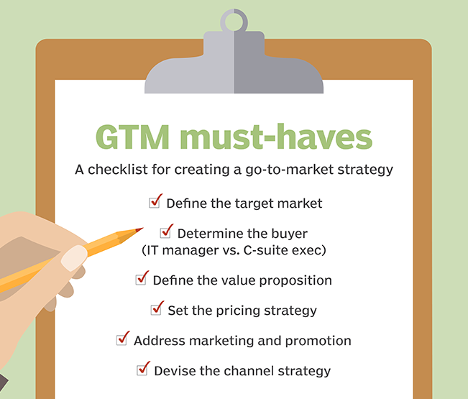
(Image source: techtarget.com)
By answering the six questions below, you will be equipped with a robust go to marketing strategy template you can use to get your new product/service ready for launch.
1. What Are Your Buyer Personas?
The first step to writing your GTM strategy is identifying your buyer personas.
A buyer persona is a semi-fictionalised depiction of your ideal customer.
Creating a list of buyer personas enables you to identify the target market/s for your product/service/business, as well as its customer base. You can then use that on your go to market plan to achieve competitive advantage against your competitors.
To build your buyer personas, you need to create persona profiles which answer the following questions:
- Gender?
- Age?
- Annual income?
- Location?
- Education?
- Industry?
- Career path?
- Size of company?
- Job role?
- Tools/skills needed to do job?
- Career aims?
- Frustrations?
- Preferred publications and social networks?
The aim is to create persona profiles that look something like this:
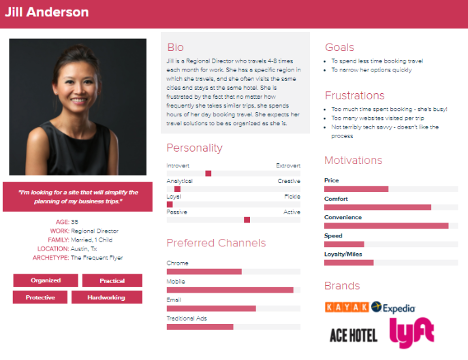
(Image source: neilpatel.com)
Learn more: How to Build Buyer Personas that Boost Sales
2. What Is Your Value Matrix?
A value matrix maps your product/service to the needs of your buyer personas and it helps you assess where you stand from a product market fit point of view.
In crafting a value matrix, you need to create a list or chart with each buyer persona in one column. Next to the personas, first list their pain points, then how your product/service can solve them. Finally, draft a key message that captures the pain point and the value of your product/service in terms of how it eases that pain.
Here’s an example:
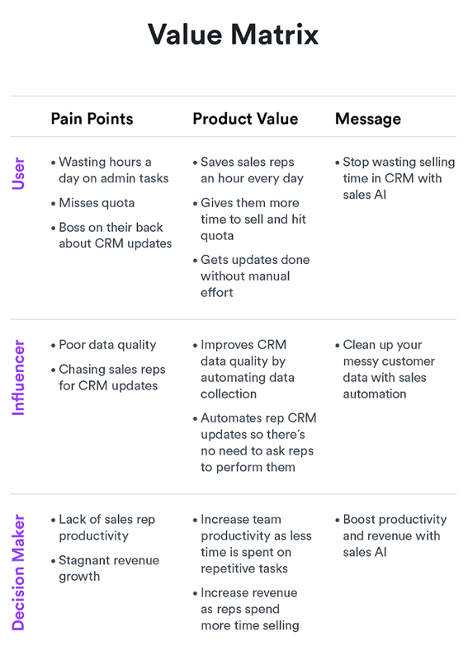
(Image source: hubspot.com)
The purpose of creating a value matrix is to determine the value proposition of your product/service, position yourself as an authority, acquire new customers and strengthen your relationships with existing customers. The value proposition should be crafted in such a way that it communicates quickly, simply, and convincingly how customers will receive more from your product/service than the monetary value paid for it. Additionally, the value proposition should also differentiate your product/service from others on the market. This ensures your product/service is perceived as providing unique value that potential customers can't get anywhere else.
3. Defining and tracking key performance metrics
As discussed before, a go-to-market strategy is crucial for the success of any new business venture. However, it's not enough to just have a great strategy in place, you will need to track and measure its effectiveness. This is where key performance metrics come into play.
Key performance metrics, or KPIs, are specific, quantifiable measures that help you evaluate the progress of your current go-to-market strategy. They can include measures such as revenue growth, customer acquisition, market share, customer satisfaction, and more. By tracking these metrics, you can determine if your strategy is working and make adjustments as needed.
When you choose to define your KPIs, it's important to start by aligning them with your business goals. For example, if your goal is to increase this year's revenue, your KPI will likely be revenue growth. If your goal is to get more customers, your KPI might be the number of new customers you acquire each quarter.
It's also essential to regularly review your KPIs to make sure they are still relevant and aligned with your business goals to adjust accordingly as your business evolves.
Having a strong understanding of your key performance metrics will help you make informed decisions and adjust your go-to-market strategy as needed. It's essential for the success of your new business venture and should not be overlooked.
4. What Is Your Pricing Strategy?
All of this information should be used to determine your pricing strategy. The price of your product/service should support the value proposition, though will ultimately depend on your target market and positioning goals.
You will also need to consider which pricing model you will use. The decision should be based on market and competitor research, with the goal of choosing a strategy that maximises profits, revenue, and shareholder value in accordance with consumer and market demand.
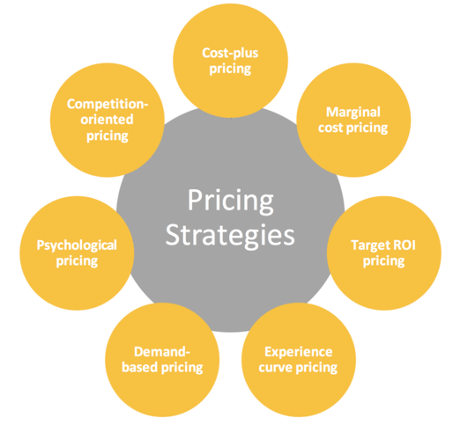
(Image source: marketing-insider.eu)
5. Define Your Marketing Strategy – What Does Your Buyer’s Journey Look Like?
You now know who your buyer is, what their pain points are, how your product/service can solve them, its price, and a list of core messages you can use in your marketing efforts.
The next stage is to model your buyer’s journey – and what your marketing strategy will look like as you nurture prospects along that journey.
Typically, the buyer’s journey consists of an awareness stage, a consideration stage, and a decision stage. Marketing materials must be created to support potential customers at each stage of this sales funnel as they are educated along the path to purchase with various content assets that highlight the core value proposition of your product/service.
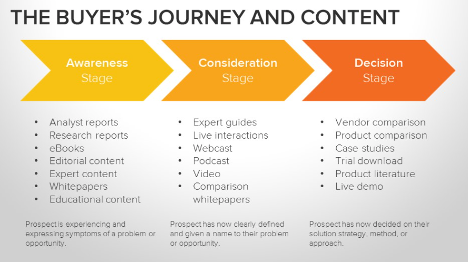
(Image source: hubspot.com)
Read more: How to Optimise Your Buyer Journey: A Step-by-Step Guide
6. What Is Your Sales Strategy?
At this point, you have completed the underlying work of determining your target audience, and how you will market your product/service to that audience. Now you need a go to market sales strategy.
There are essentially four sales strategies to choose between. The one most suited to your needs will be determined by your product/service and business model. They are:
- Self-service model: Customers complete purchases on their own. Usually adopted by B2C companies, such as ecommerce merchants or consumer-grade app or SaaS providers.
- Inside sales model: Prospects need to be nurtured by sales reps before converting into paying customers. Usually adopted by B2B sellers with products/services that aren’t too complex or expensive, yet for which there is a fair amount of competition.
- Field sales model: This model is for B2B organisations with large, complex products with high price points. A full sales organisation is typically required to support this model.
- Channel model: Business model in which third-party agencies or partners sell your products for you. Works for both B2C products as well as B2B solutions. Startups, for example, can benefit from the channel sales model as there’s no need to employ an expensive sales team while they’re still trying to get off the ground.

(Image source: hubspot.com)
Your KPIs should be meaningful, measurable, motivational, and easy to track. When it comes to sales, these will typically revolve around volume, conversion rates, the length of the sales cycle, and customer lifetime value (CLV).
Final Thoughts
Building a go to market template is crucial to set you up for a successful launch. Whether you’re a startup, developing a new product, or expanding into new markets, your GTM strategy will be both your guiding light and your glue that holds the whole operation together. If you need help developing your go to market strategy, book a free growth assessment with the GTM experts here at Incisive Edge.








